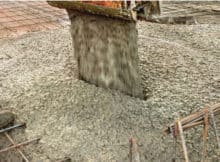What Is Lightweight Concrete?
Lightweight concrete is a blend of lightweight coarse aggregates such as shale, clay, or slate, giving it low density. The in-place density (unit weight) of structural lightweight concrete ranges from 1440 to 1840 kg/m3.

Principle Of Lightweight Concrete
1. The core principle behind the production of lightweight concrete is the introduction of air into the concrete. There are various approaches that can be taken to accomplish this. As an example:
2. Cellular porous aggregates can be used in place of traditional aggregates in concrete. (Concrete with light aggregate)
3. Concrete can be filled with air or gas bubbles (Aerated concrete).
4. Sand should not be used or should be omitted during the concrete preparation process. (Concrete with no fines.).
Characteristics of Lightweight Concrete
1. Reduced Density
The density of this concrete ranges between 300 and 1200 kg/m3. The lightest type is utilized for insulation, while the heavier type is employed for structural purposes.
Because of its low density, cellular concrete is ideal for precast roofing and floor units. Because these units are lightweight, they are easier to handle and carry from the manufacturer to the job site.
2. High Strength
Lightweight concrete has a high compressive strength in relation to its density. The compressive strength of such concrete has been observed to rise as its density increases.
It has a tensile strength that is 15 to 20% of its compressive strength. Lightweight concrete has a substantially higher strength-to-mass ratio than regular concrete.
As a result, the weight of the lightweight concrete roof slab and the floor is approximately 25% that of standard reinforced concrete.
3. Durability
Aerated concrete is slightly alkaline. Because of its porosity and low alkalinity, it does not preserve the steel reinforcement as hard compacted concrete does.
As a result, the reinforcement used in cellular concrete requires particular treatment to prevent corrosion.
4. Thermal Insulation
The insulating value of lightweight concrete is approximately three to four times that of bricks and around ten times that of concrete.
A 20 cm thick aerated concrete wall with a density of 800 kg/m3 has the same degree of insulation as a 40 cm thick brick wall with a density of 1600 kg/m3.
5.Fire Resistance
Lightweight concrete has high fire-resistant qualities. Because of its low thermal conductivity, it is useful for protecting other structures from the effects of fire.
6. Soundproofing
Lightweight concrete does not have the same level of sound isolation as dense concrete.
7. Shrinkage
Lightweight concrete shrinks very little.
8. Repairability
Lightweight concrete products are simple to cut, drill, nail, and saw. This property facilitates construction. The structure’s local repair can be dealt with as needed.
9. Speed of Construction
By utilizing unit prefabrication, the structure can be designed on the modular coordination principle, resulting in a faster pace of construction.
10. Economy
Because of the excellent strength-to-weight ratio and lightweight of concrete products, their utilization results in less steel consumption.
The use of precast un-reinforced cellular concrete blocks with reinforced concrete grid beams in composite floor construction results in significant savings in cement and steel consumption.
This significantly reduces the cost of building roofs and floors. In comparison to conventional construction, this style of construction can result in savings of roughly 15-20% in the construction of roofs and floors.
11. Quality Control
Because these units are factory built, the use of lightweight concrete products leads to improved quality control.
Types of Lightweight Concrete
1. Lightweight Aggregate Concrete
When producing lightweight aggregate concrete, an effort is taken to ensure that the aggregates used are light in weight. The most common types of aggregates are natural aggregates and man-made aggregates.
However, in most circumstances, artificial aggregates are favored over natural aggregates because artificial aggregates can be modified to meet specific needs.
If natural aggregates are used, the most commonly used natural lightweight aggregates are pumice and scoria. Artificial aggregates are typically created by altering and expanding rocks such as shale, slate, perlite, and vermiculite.
The density of concrete is determined by the type of aggregates used in its production. This form of concrete can attain concrete densities as low as 300 kg/m3. LWC compressive strength ranges from 0.3 Mpa to 40 Mpa.

Source: agg-net.com
Lightweight Aggregate Types:
Lightweight aggregates are divided into two categories:
- Lightweight natural aggregate.
- Lightweight artificial aggregate
These aggregates are further subdivided into the following categories:
| Natural Lightweight aggregates | Artificial Lightweight aggregates |
| Pumice | Artificial Cinders |
| Diatomite | Foamed Slag |
| Scrofula | Expanded shales and slates |
| Cinders from volcanoes | Bloated Clay |
| Rice Husk | Thermocol beads |
2. No-Fines Concrete
No fine aggregates are utilized in the production of No-Fines concrete. The only ingredients utilized are cement, coarse aggregates, and water.
The idea behind not employing fine particles in the creation of traditional concrete is that if only coarse aggregates are used, the concrete will have bigger voids, making it lightweight.
It is always preferable to utilize coarse particles of the same size (10- 20 mm) rather than well-graded aggregates, as this reduces the density of the concrete.
Using lighter coarse materials, densities as low as 640 kg/m3 can be reached. In this sort of structure, the cement ratio is also highly significant.

Source: firth.co.nz
3. Aerated Concrete
Aerated concrete is produced by incorporating air or gas into a slurry of portland cement or lime and finely crushed siliceous filler, resulting in an evenly cellular structure when the mix sets and hardens.
Siporex is a common aerated concrete product in India. Aerated concrete can be produced in a variety of methods. It can be produced by forming a gas through a chemical reaction within a mass while it is still in a liquid or plastic state.
By combining prefabricated stable foam and slurry. By incorporating finely powdered metal (often aluminum powder) into the slurry and allowing it to react with the calcium hydroxide produced during the hydration process

Advantages Of Lightweight Concrete
Lightweight concrete has the following advantages:
1. It minimizes the dead load of the building.
2. It is simple to handle, which decreases the cost of transportation and handling.
3. Enhances workability.
4. Thermal conductivity is decreased with lightweight concrete.
5. The use of lightweight concrete in the rooms where air conditioning is to be installed during the building’s construction would result in good thermal comfort and decreased power usage.
6. Stronger and more durable in comparison.
7. When compared to regular concrete, it has high resilience to freezing and thawing.
8. The use of lightweight concrete provides an outlet for industrial wastes such as fly ash, clinkers, slag, and so on, which cause problems in landfills.
Disadvantages Of Lightweight Concrete
1. Lightweight concrete is often particularly sensitive to the amount of water in the mix.
2. Because of the porosity and angularity of the aggregate, placement and finishing are difficult, necessitating the use of experienced labor.
3. In rare situations, cement mortar may separate the aggregates and cause them to float on the surface.
4. To ensure the correct mixing of concrete, the mixing period is longer than that of standard concrete.
5. Lightweight concrete is porous and has a low resistance.
Applications Of Lightweight Concrete
1. Because LWC has a low strength, it is utilized in the building of roof slabs, tiny houses with load-bearing walls, and so on.
2. It is also employed in the construction of staircases, windows, and garden walls, among other things.
3. This is utilized in the construction of partition walls in large buildings.
4. These are formed into slabs and utilized as thermal insulators throughout the building.
Also Read –
Types Of Concrete In Construction
If you like this article then please share it with your friends & also like our Facebook Page and join our Telegram Channel.





Good data collection